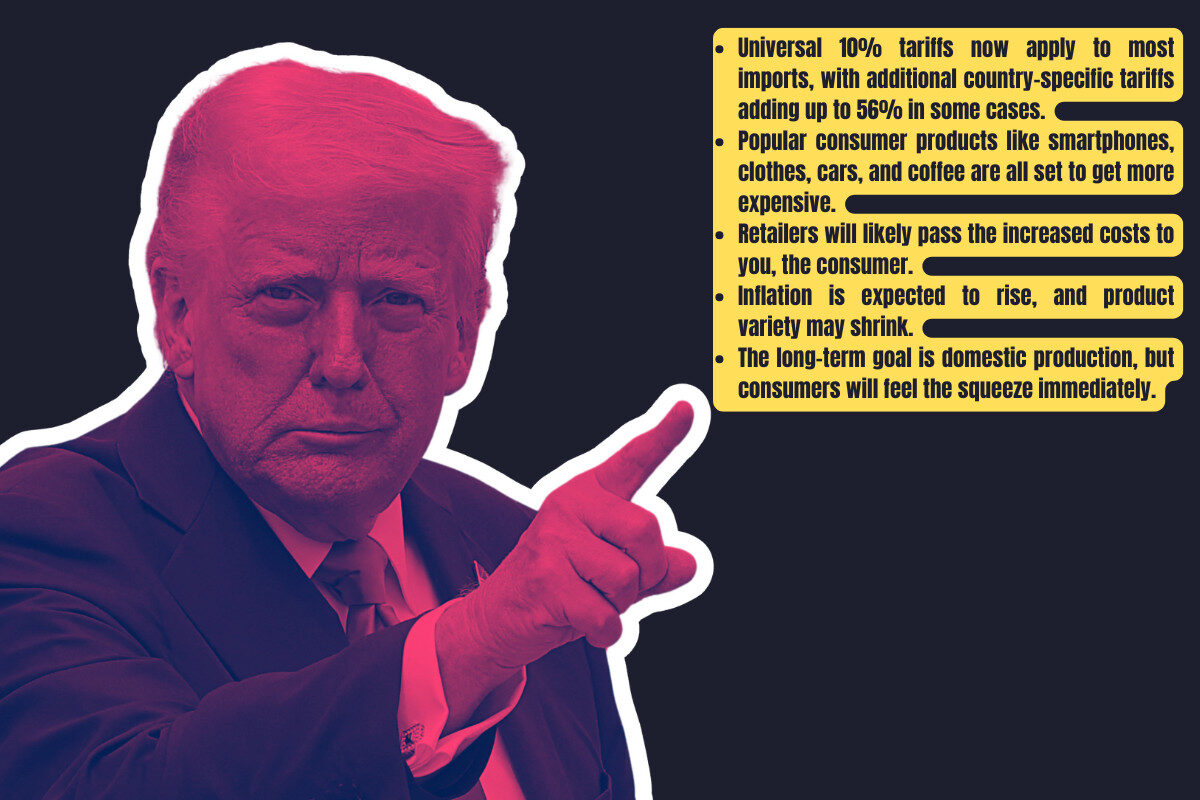TL;DR – How will Trump’s tariffs affect the cost of smartphones, consoles and other cherished consumer goods?
With a 44% total tariff on Chinese imports, don’t be surprised if prices creep up across the board on most consumer electronics.
- Universal 10% tariffs now apply to most imports, with additional country-specific tariffs adding up to 56% in some cases.
- Popular consumer products like smartphones, clothes, cars, and coffee are all set to get more expensive.
- Retailers will likely pass the increased costs to you, the consumer.
- Inflation is expected to rise, and product variety may shrink.
- The long-term goal is domestic production, but consumers will feel the squeeze immediately.
In early April 2025, President Donald Trump announced a sweeping new round of tariffs on imported goods, marking a major shift in U.S. trade policy.
Framed by the administration as a push toward economic “Liberation Day,” the new tariff regime is designed to push for more reciprocal trade practices and reduce the U.S. goods trade deficit.
But for consumers, this could mean one thing above all: higher prices on a wide range of everyday products.
Here’s a breakdown of what’s changing—and what might soon cost you more.
What’s in the New Tariffs?
At the core of the new policy is a 10% baseline tariff on nearly all imported goods, effective April 5, 2025.
On top of that, “reciprocal tariffs”—designed to mirror the duties other countries place on U.S. exports—have been applied to imports from nations with major trade surpluses with the U.S.
Economists think tariffs are a bad idea because they interfere with the principle of comparative advantage, a cornerstone of international trade theory developed by the 18th century economist David Ricardo. Ricardo showed that overall consumption and economic wellbeing increases if countries focus on producing goods they can make most efficiently (at the lowest cost compared to other goods) and trade for goods they are less efficient at producing. This allows both countries to benefit, even if one is better at producing everything – source
Here’s what that looks like:
- China: Now facing a total tariff of 54% on most goods
- EU Countries: 30% total tariff
- Japan: 34%
- Vietnam: 56%
- Bangladesh: 47%
Some product-specific tariffs are also in play:
- Imported cars: Now taxed at 35%
- Auto parts: Will face a 25% tariff from May 3, 2025
- Aluminum: Tariff rises from 10% to 25%
Goods from Canada and Mexico that comply with the USMCA remain mostly exempt—but non-compliant imports could still face steep charges.
Why This Matters: You’ll Likely Pay More
Tariffs are taxes on imports. While the political talking points suggest that exporting countries “pay” these fees, the reality is U.S. importers foot the bill—and typically pass the costs to consumers.
Major retailers are already signaling price hikes ahead.
The last time Trump imposed major tariffs, appliance prices jumped by double digits. This time, the effect could be even broader.
10 Popular Products That Are Likely to Get More Expensive
We’ve identified ten key product categories likely to be hit hardest by the new tariffs:
| Product Category | Example Products | Main Sources | Total Tariff % |
|---|---|---|---|
| Smartphones | iPhone, Android phones | China, India | 44% (China), 36% (India) |
| Apparel | Clothing, Shoes | China, Vietnam, Bangladesh | 44%–56% |
| Automobiles | Imported cars | Japan, EU | 55%–59% |
| Furniture | Sofas, Tables, Beds | China, Vietnam | 44%–56% |
| Wine & Spirits | Wine, Whisky | EU, UK | 20%–30% |
| Coffee | Coffee Beans | Brazil, Colombia | 20% |
| Cocoa Products | Chocolate, Cocoa | Côte d’Ivoire, Ecuador | 20%–31% |
| Appliances | Washers, Refrigerators | China, South Korea | 10% + varies |
| Toys | Action figures, Dolls | China | 44% |
| Fresh Produce | Avocados | Mexico (non-USMCA) | 35% |
A Closer Look at Smartphones
China still dominates global smartphone manufacturing. Even though Apple is slowly shifting production to India, the majority of iPhones (and many Android devices) are still made in China.
With a 44% total tariff on Chinese imports, don’t be surprised if prices creep up—even on future iPhones.
🧠 Pro Tip: If you’re looking to save on your next phone, refurbished models are a smart move. They’re cheaper, eco-friendly, and often just as reliable.
👉 Check out our refurbished phone guid
What It Means for the U.S. Economy
While the goal of these tariffs is to bring manufacturing back to the U.S., economists warn that the shift won’t happen overnight. Setting up domestic factories, training workers, and rebuilding supply chains is a multi-year process.
In the short term? Expect:
- Higher prices across major product categories
- Reduced product variety if importers pull certain items
- Increased inflation, lowering consumer purchasing power
- Potential trade retaliation from affected countries
And let’s be clear—this won’t just affect luxury items. Everyday essentials like clothing, food, and electronics are all in the crosshairs.
Key Takeaways
- Universal 10% tariffs now apply to most imports, with additional country-specific tariffs adding up to 56% in some cases.
- Popular consumer products like smartphones, clothes, cars, and coffee are all set to get more expensive.
- Retailers will likely pass the increased costs to you, the consumer.
- Inflation is expected to rise, and product variety may shrink.
- The long-term goal is domestic production, but consumers will feel the squeeze immediately.
FAQs
Will this affect iPhone prices?
Likely, yes. A significant portion of iPhones are still assembled in China, and the new 44% tariff on Chinese electronics will increase production costs.
Is there any way to avoid paying more?
Consider buying refurbished phones or appliances. You can also seek out domestically produced alternatives, though those may still carry higher prices.
What about food and drink?
Yes—expect increases on imported items like coffee, wine, avocados, and chocolate.
Will U.S. companies move production home?
Possibly, but it will take time. Building up domestic manufacturing capacity isn’t something that happens overnight.
Looking to stay ahead of the curve on mobile tech, policy shifts, and smart ways to save?
Sign up to our newsletter, The I/O, and we’ll keep you updated—no fluff, just the good stuff.





